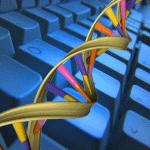Bioinformatics
|
28 june 2016 01:04:18 |
| FF12MC: A revised AMBER forcefield and new protein simulation protocol (Proteins: Structure, Function, and Bioinformatics) |
|
Tweet Specialized to simulate proteins in molecular dynamics (MD) simulations with explicit solvation, FF12MC is a combination of a new protein simulation protocol employing uniformly reduced atomic masses by tenfold and a revised AMBER forcefield FF99 with (i) shortened C-H bonds, (ii) removal of torsions involving a nonperipheral sp3 atom, and (iii) reduced 1-4 interaction scaling factors of torsions ? and ?. This article reports that in multiple, distinct, independent, unrestricted, unbiased, isobaric-isothermal, and classical MD simulations FF12MC can (i) simulate the experimentally observed flipping between left- and right-handed configurations for C14-C38 of BPTI in solution, (ii) autonomously fold chignolin, CLN025, and Trp-cage with folding times that agree with the experimental values, (iii) simulate subsequent unfolding and refolding of these miniproteins, and (iv) achieve a robust Z score of 1.33 for refining protein models TMR01, TMR04, and TMR07. By comparison, the latest general-purpose AMBER forcefield FF14SB locks the C14-C38 bond to the right-handed configuration in solution under the same protein simulation conditions. Statistical survival analysis shows that FF12MC folds chignolin and CLN025 in isobaric-isothermal MD simulations 2-4 times faster than FF14SB under the same protein simulation conditions. These results suggest that FF12MC may be used for protein simulations to study kinetics and thermodynamics of miniprotein folding as well as protein structure and dynamics. This article is protected by copyright. All rights reserved. |
| 192 viewsCategory: Biochemistry, Bioinformatics |
 Accelerated Molecular Dynamics Simulations of the Octopamine Receptor using GPUs: Discovery of an Alternate Agonist-Binding Position (Proteins: Structure, Function, and Bioinformatics) Accelerated Molecular Dynamics Simulations of the Octopamine Receptor using GPUs: Discovery of an Alternate Agonist-Binding Position (Proteins: Structure, Function, and Bioinformatics)Novel proteases from the genome of the carnivorous plant Drosera capensis: Structural prediction and comparative analysis (Proteins: Structure, Function, and Bioinformatics) 
|
| blog comments powered by Disqus |
MyJournals.org
The latest issues of all your favorite science journals on one page
The latest issues of all your favorite science journals on one page



